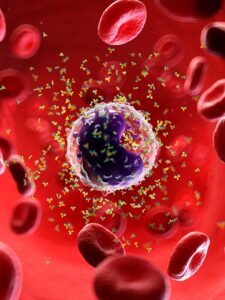Select patients with chronic anemia and sickle cell disease require recurrent transfusions and are at risk for alloimmunization and potentially harmful hemolytic transfusion reactions. In order to better understand the factors and mechanisms behind RBC removal, researchers developed an incompatible transfusion model using donor mice that express different levels of the KEL antigen on RBCs and recipient mice with varying levels of alloantibodies to the KEL antigen. When alloimmunized mice were transfused RBCs that express moderate or high levels of KEL antigen, KEL-specific RBCs were rapidly cleared. Few RBCs were cleared in alloimmunized mice when transfused with RBCs expressing low levels of KEL antigen. However, KEL antigen modulation was not found to be dependent on antigen density following an incompatible transfusion and occurred at high, medium and low antigen density levels. These results suggest that antigen thresholds for RBC clearance and antigen modulation are distinct. Further studies are needed to understand these complex pathways in order to reduce the risk of RBC clearance and hemolysis in chronically transfused patients.
Reference:

